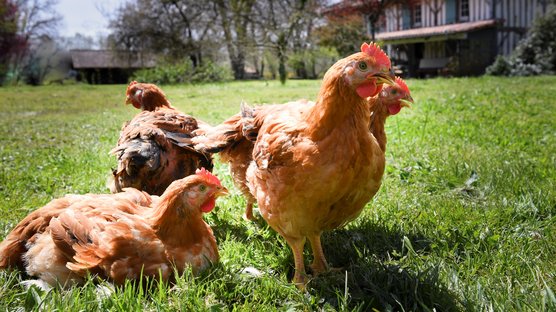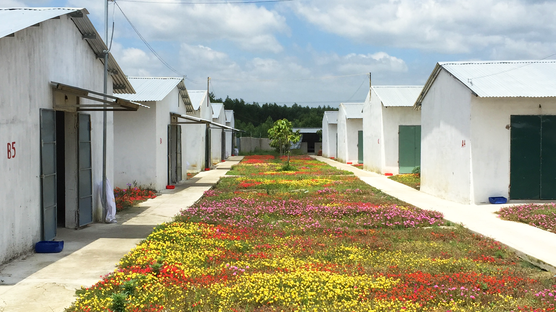
Published on Oct. 16, 2023
How to achieve high-performance production: transfers, light programs and nutrition
The success of production depends mainly on starting and the rearing phase.
If all the recommendations have been followed,there is no reason why production should not be well done. A hen in good health, at the right weight and the right stage of sexual maturity will be a good layer. A male in good health and with adequate testicular development will be a good breeder.
The transfer
When the animals are transferred into the reproduction buildings the flocks’ data should accompany the batches. In order to limit the effects of transfer, the animals should be placed in a building in which the hygrometry and temperature conditions are equivalent to those of the rearing building. The increase of temperature in the reproduction building will therefore be planned as a consequence.
The transfer is generally performed between the 19th and the 20th week. This operation makes it possible to control the sexual maturity of the flock. It is compulsory for it to take place 2 to 3 weeks before the hens start laying in order to facilitate the mixing of males and females, to encourage them to get used to a new environment and to limit floor laying.
There is a wide variety of reproduction buildings: dark or open, with automatic or manual nests, with or without duckboards, etc. Most of the buildings allow good reproduction and laying on condition that several batch management rules are respected.
It should be noted that some production systems use the same building for rearing and production. Manual nests are added at about the 18th week in order to accustom the females to climb on them. In this case transfer simply involves mixing the males and females.
Transfer of the roots
We recommend making the transfer between 19 and 20 weeks.
Depending on the temperature, the farmer will not hesitate to heat the building before the arrival of the roosters. The males are transferred 3 to 5 days before the females so that they become accustomed to finding their food, particularly after rearing with feed chains or pellets on the floor. This procedure prevents the males from losing weight at the critical moment at the start of production (which will harm their fertility greatly).
To encourage their feed intake and their distribution in the building, hoppers and chains will be distributed additionally along the length of the building.
Furthermore, we encourage the roosters to find the feeders as follows:
- remove the litter under the roosters’ feeders
- place the roosters’ feeders at floor level
- distribute the feed in the presence of the roosters
- drop feed around the feeders so that the roosters, floor fed in the rearing house, find the feeders
- in the days before the arrival of the hens, the roosters’ feeders will be raised progressively so that when the females arrive in the building, only the males can access them.
For roosters of the T lines possibly reared with hens, which are rationed, it is necessary to add hoppers as in the previous point.

Management of sexuality maturity
The males may be too mature or not mature enough, or the batch may have males at different stages of maturity. Fine-tuning of the introduction of males into the batch of females is suitable.
Males that are insufficiently mature compared to the females:
In the case where the males are too immature, they should be left in the rearing house until they are ready, without the females gaining the upper hand and making the males fearful (which would result in low fertility).
Males that are too mature compared to the females:
Roosters that are too mature or too numerous would frighten the females, which would cause very high fertility initially. Females that have become fearful will not long tread, drastically reducing the fertility of eggs in the following period.
If it is thought that the roosters are too mature, it is recommended that they are introduced progressively, by 3% stages every week for example. The introduction of the males should be performed in the evening to facilitate their integration. As a priority the most mature roosters should be introduced progressively.
SASSO genetics offer excellent fertility. Depending upon the quality of the management it is possible to have optimal results with only about 7 to 8% of males.
Transfer of the hens
We recommend making the transfer between 19 and 20 weeks.
Transfer causes disruption to the hen’s habits and several hours may elapse before she can have access to water. It is important to promote rehydration of the hens by only offering feed 2 to 3 hours after the transfer to leave them the time to drink.
By increasing the duration of lighting on the first day (24 hours) we ensure that the hen discovers her new environment correctly, drinks and feeds correctly. In fact, hens are very sensitive to various changes. High stress encourages panic reactions and therefore suffocation situations.
FROM TRANSFER THE FEED RATION MOVES FROM THE 5/7 SYSTEM TO THE 7/7 SYSTEM
As the roosters are in the presence of the hens and cannot endure the 5/7 regime, it is important to move the females onto 7/7. In order to facilitate adaptation to a new environment the quantity of the 5/7 ration can be kept each day for one or two days before distributing the 7/7 ration.
Example: hens on 5/7 are transferred at 20 weeks. Up until then they received a feed ration of 98 g on the days with feed. After transfer 98 g of feed every day is kept for one or two days and then they have 70 g of feed distributed each day.
If the hens are overweight, it is preferable to keep the 7/7 quantity after transfer.
Feed consumption will be stimulated by allowing the feeders to empty between meals (in order to prevent the finest part of the ration being routinely left), by limiting the number of distributions and using a suitable, so-called “pre-laying” formula.
Light programme applied to breeders
When laying has not started (less than 0.5% laying) the light duration remains equal to the duration of natural light at 20 weeks.
From transfer at 19-20 weeks the light intensity is increased to the maximum. Keeping a low light intensity increases the risk of floor laying.
Once production starts (0.5% laying) the duration of lighting is increased by one hour each week (+30 minutes in the morning, +30 minutes in the evening).
This duration should be stabilized at 16 h of lighting per day throughout the entire production of a batch. Here also it is necessary to make the duration of artificial day and the duration of natural day coincide as far as possible.
Nutrition for roosters
The roosters must be maintained at the correct weight, i.e. in the interval described in the SASSO recommendations. The weight should be sufficient to allow good carcass development and good sexual maturity when the time comes.
To provide the males with a sufficient quantity of feed in the presence of the females, additional feeders are place at a height for the roosters.






